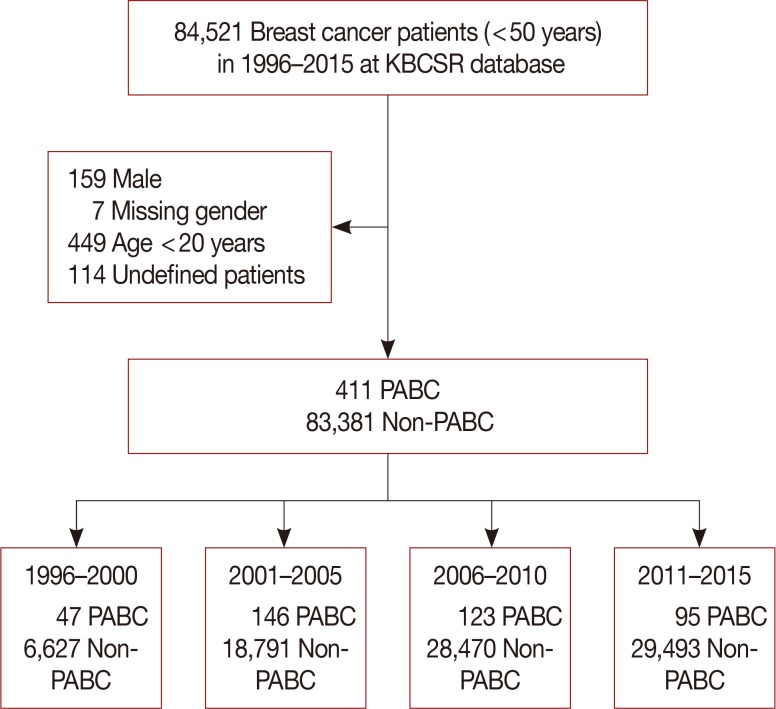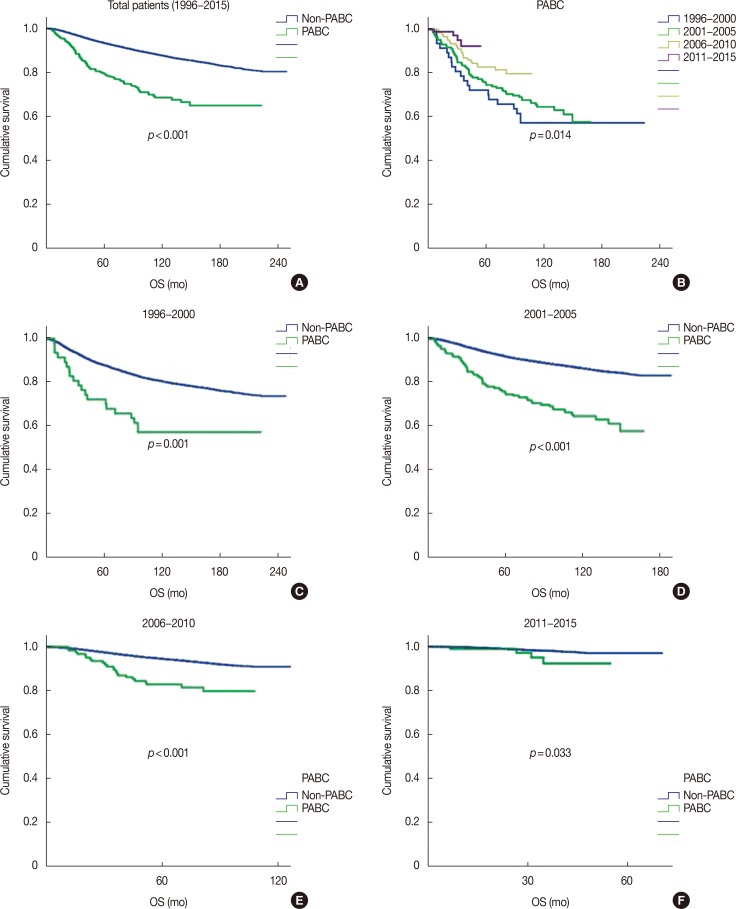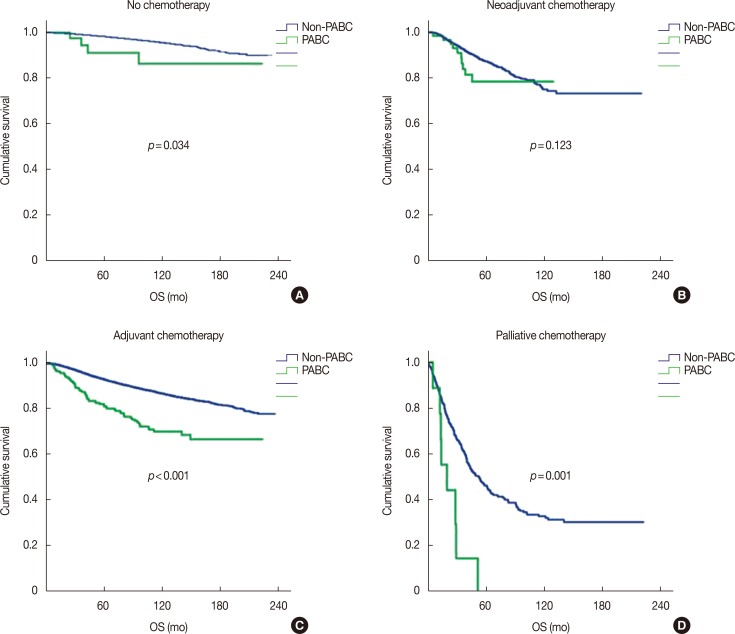J Breast Cancer.
2018 Dec;21(4):425-432. 10.4048/jbc.2018.21.e58.
Neoadjuvant Chemotherapy and Prognosis of Pregnancy-Associated Breast Cancer: A Time-Trends Study of the Korean Breast Cancer Registry Database
- Affiliations
-
- 1Department of Surgery, Korea University Anam Hospital, Korea University College of Medicine, Seoul, Korea. jungspil@korea.ac.kr
- 2Breast-Thyroid Center, Ulsan City Hospital, Ulsan, Korea.
- 3Department of Surgery, Uijeongbu St. Mary's Hospital, College of Medicine, The Catholic University of Korea, Uijeongbu, Korea.
- 4Department of Surgery, Asan Medical Center, University of Ulsan College of Medicine, Seoul, Korea.
- 5Department of Surgery, Yonsei University College of Medicine, Seoul, Korea.
- 6Department of Surgery, Pusan National University Hospital, Pusan National University School of Medicine, Busan, Korea.
- 7Breast-Thyroid Center, Saegyaero Hospital, Busan, Korea.
- KMID: 2429821
- DOI: http://doi.org/10.4048/jbc.2018.21.e58
Abstract
- PURPOSE
Pregnancy-associated breast cancer (PABC) is rare, and its cause and prognosis are not well known. Additionally, treatment is limited with respect to the risk to the fetus. The purpose of this study was to investigate the characteristics and treatment trends of PABC and the survival rate according to the treatment.
METHODS
In the Korean Breast Cancer Society Registry database, women younger than 50 years and who were diagnosed with breast cancer from 1996 to 2015 were included. PABC was defined as breast cancer diagnosed during pregnancy or within 1 year after delivery.
RESULTS
We examined 411 patients with PABC and 83,381 patients with non-PABC. Over time, the proportions of patients undergoing breast-conserving surgery and sentinel lymph node biopsy increased, and neoadjuvant chemotherapy and radiation therapy administration rates also increased. In the past, the overall survival of patients with PABC was poorer than that of patients with non-PABC, but there was no difference in overall survival rates in more recent years. There was no difference in overall survival rates between patients who received neoadjuvant chemotherapy (hazard ratio [HR], 1.28; 95% confidence interval [CI], 0.66-2.49; p=0.459), but PABC conferred poorer prognosis than non-PABC in patients receiving adjuvant chemotherapy (HR, 1.63; 95% CI, 1.27-2.08; p < 0.001).
CONCLUSION
There was no difference in the prognosis between patients with PABC and those with non-PABC receiving neoadjuvant chemotherapy. The increase in neoadjuvant chemotherapy according to current treatment guidelines is expected to improve the survival rate of patients with PABC.
Keyword
MeSH Terms
Figure
Reference
-
1. Smith LH, Danielsen B, Allen ME, Cress R. Cancer associated with obstetric delivery: results of linkage with the California cancer registry. Am J Obstet Gynecol. 2003; 189:1128–1135. PMID: 14586366.
Article2. Parente JT, Amsel M, Lerner R, Chinea F. Breast cancer associated with pregnancy. Obstet Gynecol. 1988; 71(6 Pt 1):861–864. PMID: 2835718.3. Lee YY, Roberts CL, Dobbins T, Stavrou E, Black K, Morris J, et al. Incidence and outcomes of pregnancy-associated cancer in Australia, 1994–2008: a population-based linkage study. BJOG. 2012; 119:1572–1582. PMID: 22947229.
Article4. Stensheim H, Møller B, van Dijk T, Fosså SD. Cause-specific survival for women diagnosed with cancer during pregnancy or lactation: a registry-based cohort study. J Clin Oncol. 2009; 27:45–51. PMID: 19029418.
Article5. Amant F, von Minckwitz G, Han SN, Bontenbal M, Ring AE, Giermek J, et al. Prognosis of women with primary breast cancer diagnosed during pregnancy: results from an international collaborative study. J Clin Oncol. 2013; 31:2532–2539. PMID: 23610117.
Article6. Litton JK, Warneke CL, Hahn KM, Palla SL, Kuerer HM, Perkins GH, et al. Case control study of women treated with chemotherapy for breast cancer during pregnancy as compared with nonpregnant patients with breast cancer. Oncologist. 2013; 18:369–376. PMID: 23576478.
Article7. Hartman EK, Eslick GD. The prognosis of women diagnosed with breast cancer before, during and after pregnancy: a meta-analysis. Breast Cancer Res Treat. 2016; 160:347–360. PMID: 27683280.
Article8. Azim HA Jr, Peccatori FA, Brohée S, Branstetter D, Loi S, Viale G, et al. RANK-ligand (RANKL) expression in young breast cancer patients and during pregnancy. Breast Cancer Res. 2015; 17:24. PMID: 25849336.
Article9. Azim HA Jr, Brohée S, Peccatori FA, Desmedt C, Loi S, Lambrechts D, et al. Biology of breast cancer during pregnancy using genomic profiling. Endocr Relat Cancer. 2014; 21:545–554. PMID: 24825746.
Article10. Kroman N, Mouridsen HT. Prognostic influence of pregnancy before, around, and after diagnosis of breast cancer. Breast. 2003; 12:516–521. PMID: 14659129.
Article11. Woo JC, Yu T, Hurd TC. Breast cancer in pregnancy: a literature review. Arch Surg. 2003; 138:91–98. PMID: 12511159.12. Paluch-Shimon S, Pagani O, Partridge AH, Abulkhair O, Cardoso MJ, Dent RA, et al. ESO-ESMO 3rd international consensus guidelines for breast cancer in young women (BCY3). Breast. 2017; 35:203–217. PMID: 28822332.
Article13. Johansson AL, Andersson TM, Hsieh CC, Jirström K, Cnattingius S, Fredriksson I, et al. Tumor characteristics and prognosis in women with pregnancy-associated breast cancer. Int J Cancer. 2018; 142:1343–1354. PMID: 29168177.
Article14. Eibye S, Kjær SK, Mellemkjær L. Incidence of pregnancy-associated cancer in Denmark, 1977-2006. Obstet Gynecol. 2013; 122:608–617. PMID: 23921869.
Article15. Loibl S, Schmidt A, Gentilini O, Kaufman B, Kuhl C, Denkert C, et al. Breast cancer diagnosed during pregnancy: adapting recent advances in breast cancer care for pregnant patients. JAMA Oncol. 2015; 1:1145–1153. PMID: 26247818.
Article16. Min SY, Kim Z, Hur MH, Yoon CS, Park EH, Jung KW, et al. The basic facts of Korean breast cancer in 2013: results of a nationwide survey and breast cancer registry database. J Breast Cancer. 2016; 19:1–7. PMID: 27066090.
Article17. Ahn SH, Son BH, Kim SW, Kim SI, Jeong J, Ko SS, et al. Poor outcome of hormone receptor-positive breast cancer at very young age is due to tamoxifen resistance: nationwide survival data in Korea: a report from the Korean Breast Cancer Society. J Clin Oncol. 2007; 25:2360–2368. PMID: 17515570.18. Kim YG, Jeon YW, Ko BK, Sohn G, Kim EK, Moon BI, et al. Clinicopathologic characteristics of pregnancy-associated breast cancer: results of analysis of a nationwide breast cancer registry database. J Breast Cancer. 2017; 20:264–269. PMID: 28970852.
Article19. Raut CP, Daley MD, Hunt KK, Akins J, Ross MI, Singletary SE, et al. Anaphylactoid reactions to isosulfan blue dye during breast cancer lymphatic mapping in patients given preoperative prophylaxis. J Clin Oncol. 2004; 22:567–568. PMID: 14752082.
Article20. Gropper AB, Calvillo KZ, Dominici L, Troyan S, Rhei E, Economy KE, et al. Sentinel lymph node biopsy in pregnant women with breast cancer. Ann Surg Oncol. 2014; 21:2506–2511. PMID: 24756813.
Article21. Pandit-Taskar N, Dauer LT, Montgomery L, St Germain J, Zanzonico PB, Divgi CR. Organ and fetal absorbed dose estimates from 99mTc-sulfur colloid lymphoscintigraphy and sentinel node localization in breast cancer patients. J Nucl Med. 2006; 47:1202–1208. PMID: 16818956.22. Cardonick E, Iacobucci A. Use of chemotherapy during human pregnancy. Lancet Oncol. 2004; 5:283–291. PMID: 15120665.
Article23. Bines J, Earl H, Buzaid AC, Saad ED. Anthracyclines and taxanes in the neo/adjuvant treatment of breast cancer: does the sequence matter? Ann Oncol. 2014; 25:1079–1085. PMID: 24625452.
Article24. Loibl S, Han SN, von Minckwitz G, Bontenbal M, Ring A, Giermek J, et al. Treatment of breast cancer during pregnancy: an observational study. Lancet Oncol. 2012; 13:887–896. PMID: 22902483.
Article25. National Toxicology Program. NTP monograph: developmental effects and pregnancy outcomes associated with cancer chemotherapy use during pregnancy. NTP Monogr. 2013; (2):i–214. PMID: 24736875.26. Lenhard MS, Bauerfeind I, Untch M. Breast cancer and pregnancy: challenges of chemotherapy. Crit Rev Oncol Hematol. 2008; 67:196–203. PMID: 18394918.
Article27. Molckovsky A, Madarnas Y. Breast cancer in pregnancy: a literature review. Breast Cancer Res Treat. 2008; 108:333–338. PMID: 17530426.
Article28. Genin AS, Lesieur B, Gligorov J, Antoine M, Selleret L, Rouzier R. Pregnancy-associated breast cancers: do they differ from other breast cancers in young women? Breast. 2012; 21:550–555. PMID: 22698618.
Article
- Full Text Links
- Actions
-
Cited
- CITED
-
- Close
- Share
- Similar articles
-
- Breast Cancer During Pregnancy
- Breast Cancer during Pregnancy
- Comment on “Histomorphological Factors Predicting the Response to Neoadjuvant Chemotherapy in Triple-Negative Breast Cancerâ€
- Predictive and Prognostic Roles of Pathological Indicators for Patients with Breast Cancer on Neoadjuvant Chemotherapy
- A Case of Pregnancy-Associated Breast Cancer




